A Refreshed Mainstay Glides into Middle-Age
After more than a decade of wild growth and nearly limitless prosperity, Toyota experienced an unthinkable 2010 – the bandwagon derailed in a very ugly, very public way. Embarrassing recalls played their role in the Japanese automaker's uncharacteristic slide, but even though that public black eye is beginning to heal, Toyota is still grappling with an aging product lineup. The Camry and Corolla still sell in massive numbers, but they're growing long in the tooth. Admittedly, the latter received a very mild refresh for 2011, but the competition has caught up with each in every category that counts. It's much the same story for Toyota's truck and SUV portfolio, where the RAV4, Tacoma, FJ Cruiser and Tundra are hardly spring chickens.
Compounding the issue is the lukewarm response to some of its newly refreshed. The styling remains staid. The interiors are no longer class-leading. The powertrains and fuel economy have done little to separate them from the rest of the pack. Still, not all Toyota models are headed off the reservation. The redesigned Sienna has been well-received and is doing good work on the sales floor. The same can still be said for the Prius and the redesigned 4Runner, which is selling far better than its predecessor. The subject of Toyota's latest refresh and the vehicle featured here, the 2011 Highlander, has been consistently successful over its lifespan. Will new tweaks to the seven-passenger crossover help this perennial top-seller stay near the top of the pack, or could the lack of a more comprehensive redesign relegate this CUV to also-ran status?
Continue reading...
2011 Toyota Highlander – Click above for high-res image gallery
After more than a decade of wild growth and nearly limitless prosperity, Toyota experienced an unthinkable 2010 – the bandwagon derailed in a very ugly, very public way. Embarrassing recalls played their role in the Japanese automaker's uncharacteristic slide, but even though that public black eye is beginning to heal, Toyota is still grappling with an aging product lineup. The Camry and Corolla still sell in massive numbers, but they're growing long in the tooth. Admittedly, the latter received a very mild refresh for 2011, but the competition has caught up with each in every category that counts. It's much the same story for Toyota's truck and SUV portfolio, where the RAV4, Tacoma, FJ Cruiser and Tundra are hardly spring chickens.
Compounding the issue is the lukewarm response to some of its newly refreshed. The styling remains staid. The interiors are no longer class-leading. The powertrains and fuel economy have done little to separate them from the rest of the pack. Still, not all Toyota models are headed off the reservation. The redesigned Sienna has been well-received and is doing good work on the sales floor. The same can still be said for the Prius and the redesigned 4Runner, which is selling far better than its predecessor. The subject of Toyota's latest refresh and the vehicle featured here, the 2011 Highlander, has been consistently successful over its lifespan. Will new tweaks to the seven-passenger crossover help this perennial top-seller stay near the top of the pack, or could the lack of a more comprehensive redesign relegate this CUV to also-ran status?
Continue reading...
Photos copyright ©2011 Chris Shunk / AOL
With over 92,000 sales in 2010, it's clear that CUV shoppers are at least considering the Highlander. In fact, the only three-row crossovers that have been more successful are the Chevrolet Traverse and Honda Pilot, with 107,000 and 102,000 units sold respectively. To keep customers streaming into the showroom, Toyota has updated its bread-and-butter CUV with updates like bolder projector-style headlamps and standard three-row seating. Limited-spec models like our tester start at $36,575 in front-wheel drive guise and $37,375 with all-wheel drive, and all trim levels receive a standard power liftgate, satellite radio and connectivity features including Bluetooth and USB. Each Limited model also comes with standard heated front seats and a no-charge power moonroof. Among the options checked off on our $43,635 all-wheel drive tester included a $4,630 infotainment package that bundles together a nine-inch navigation screen, rear seat DVD and a premium JBL sound system. Other standard features on the Limited trim level include 19-inch wheels, a 10-way power driver's seat and tri-zone climate control.
New features usually help move more models, but refreshed aesthetics do a lot to bring customers to dealerships. In that spirit, the Highlander has been given a thorough nose job for 2011, with a chiseled beak that gives a more muscular appearance. An aggressive new lower air dam has been added, along with attractive new fog lamps, a freshly stamped hood and convex headlamp covers that closely resemble those of the new-for-2010 4Runner. But while the headlamps on the 4Runner look like woefully unkempt eyebrows, the same look is far better resolved on the Highlander. Out back, there haven't been many changes, though the tail lamps have been slightly reworked. We've seen more thorough exterior refreshes from other companies as of late, but Toyota has pulled off a fresh, attractive look without breaking a sweat, or the bank.
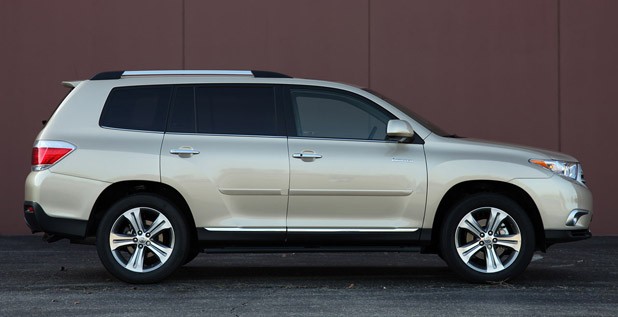
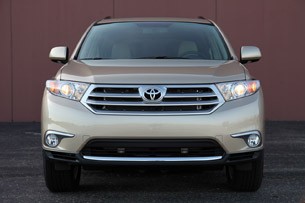
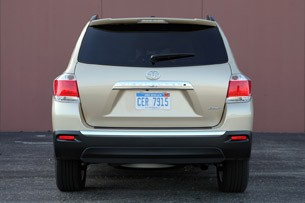
It's a good thing Toyota's piggy bank is free of fissures, as that's left more dough to upgrade the Highlander's interior, right? Well, not so much. Outside of additional standard features like heated seats and various tech upgrades, the Highlander's cabin is largely carryover. Thankfully, the front seats are still comfortable and reasonably bolstered. Controls and ergonomics are still well thought-out. The leather-wrapped steering wheel is still a pleasure to grip. And our favorite touch? The Highlander's glovebox is Mammoth Cave huge.
At the same time, the dash continues to lack any manner of soft-touch materials. The center armrest is covered with soft touch leather, but it's not the plush cowhide you'll find in similarly priced crossovers like the Ford Flex Limited. The same can be said for the anonymous looking leather seats – two seconds after leaving the cabin, you forget about them entirely, and you can only describe what they're like under hypnosis. At least they don't leave your back knotted up.
Speaking of seats, the Highlander's second- and third-row accommodations are pretty trick. For instance, both rows have the ability to fold completely flat, revealing 95 cubic feet of cargo space. That's nearly 30 more cubes than the similarly sized Dodge Journey and a dozen more than the much longer Flex. Want captain's chairs? Toyota has engineered a removable middle seat that stows neatly into a storage bin below the center armrest. We've created a short video to show how easy it is to operate (above). While we liked how well thought-out the storage solution is, we weren't as thrilled with the actual seat. It's actually indented compared to the other two squabs, and it's only about seven or eight inches wide – far too narrow for most backsides, and the ones that fit should typically be anchored to a booster seat. We don't know of many boosters that fit in such a tight space.
Then there is the third row. It's elevated to give occupants the feeling of spaciousness, but no amount of elevation can trick adult-sized passengers into feeling comfortable back there. And with that third row in use, there is only 10 cubic feet of space available for cargo. That's about enough space for four small bags of groceries, which is fine most of the time, but on a trip, passengers will have luggage at their feet. The significantly larger yet similarly priced Chevy Traverse, on the other hand, offers 24 cubes, while the Honda Pilot holds 18.
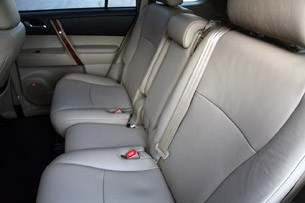
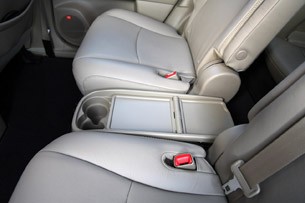
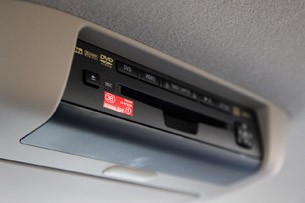
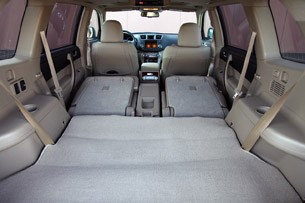
On the tech front, our tester was equipped with a USB port and Bluetooth, enabling drivers to pair up mobile phones and plug in their iPod. We found the rear seat entertainment system to be well-executed, with simple controls and quality headphones that worked without requiring a trip to the owner's manual. The optional JBL sound system was similarly excellent, with crisp, clear music that filled the cabin. But while the tech story is a page-turner, in the end, antagonism wins the day. For example, while the new nine-inch nav is nicely backlit and visually impressive, navigating the menus occasionally proved to be as difficult as finding the destination without a map. What's more, the touchscreen was hard to operate, requiring unusually firm pressure on the screen to elicit a response. And if you use the head unit to change radio stations, you must first press on the tuning knob at the far end of the center stack, giving drivers one more reason to take their eyes off the road. The same can be said for the Multi-Information Display, which sits at the crest of the console. The small yet colorful display houses vehicle information ranging from fuel economy to climate control settings, but we'd prefer that information migrate over into our line of site between the gauges.
So you've gathered that we're not completely impressed with the Highlander's interior, but what about the driving experience? The Highlander retains the same 3.5-liter V6 that Toyota employs in most of its car-based models. The carryover six-cylinder continues to offer 270 horsepower at 6,200 rpm and 248 pound-feet of torque at 4,700 revolutions, backed by a five-speed automatic (curiously, if you want a six-speed automatic you'll have to step down to the 2.7-liter inline-four). Five forward gears isn't exactly cutting edge, but Toyota engineers have tweaked this tried-and-true powertrain to the point of near perfection. Shifts are seamless and power-delivery is smooth, effortlessly propelling this nearly 4,300-pound machine.
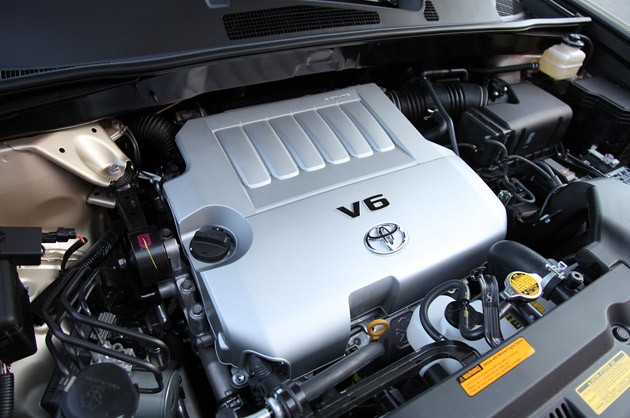
The Highlander's chassis and suspension are up to the task as well, with reasonably responsive handling that can still soak up most bumps in the road. Those looking for a slightly more athletic driving experience can specify the slightly firmer Sport model. Stopping is a similarly effortless affair, and the 2011 Highlander now comes equipped with a brake override system that kills the throttle in the event that both pedals are pressed simultaneously. The Highlander's electronic power steering is minimally engaging, but that's expected (and in many cases, preferred) by CUV owners. Its turning radius is also less-than-ideal, but this is also typical of mid-size crossovers
Our Limited tester also boasted a 4WD badge on the boot, but a more apt moniker would be full-time AWD. After all, there is no low-range gear and you certainly won't hear a grinding sound when turning on dry pavement. We would have loved to experience the foul-weather benefits of this system first-hand, but saw only dry pavement during our evaluation. Inevitably, driving all four wheels dings the fuel economy numbers a bit, as the Limited 4WD model manages middling EPA numbers of 17 miles per gallon in the city and 22 mpg on the highway. Our tester managed to hover between 19 and 20 mpg, about par for the course in this segment. If that's not good enough, there's always the Highlander Hybrid, which starts at $37,490 and boasts a combined rating of 28 mpg.
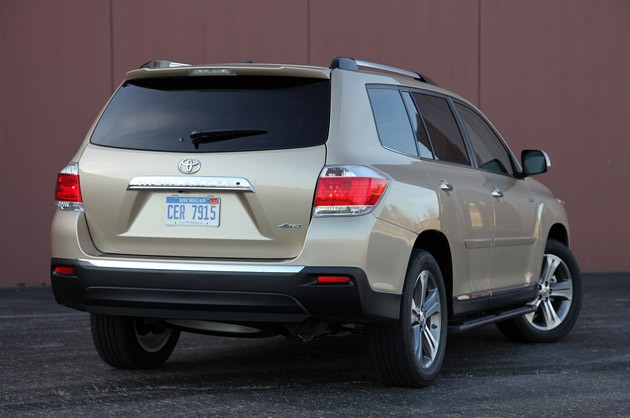
After a week with the 2011 Toyota Highlander, we came away impressed with its updated sheetmetal and pleased with its all-around driving characteristics. Where does the Highlander come up short? For starters, the mostly unchanged interior struggles to keep up with the best the segment has to offer. Beyond that, this well-regarded crossover compromises too much space in an effort to call itself a seven-passenger crossover. The disappearing second row seat is too small to be comfortably used by most on long journeys, and the convertible captain's chairs simply aren't as plush or comfy as dedicated thrones. Third-row seating is also too cramped for extended travel, and with a full complement of passengers, the cargo area is too space-challenged for real-world use. And yet, we know there are plenty of Toyota loyalists and new consumers who will be more than happy to live with these shortcomings – and precious few of them will make frequent use of the third row anyhow.
Ultimately, the refreshed Highlander remains an imperfect but attractive option in one of America's most hotly contested segments – but only just.
Photos copyright ©2011 Chris Shunk / AOL


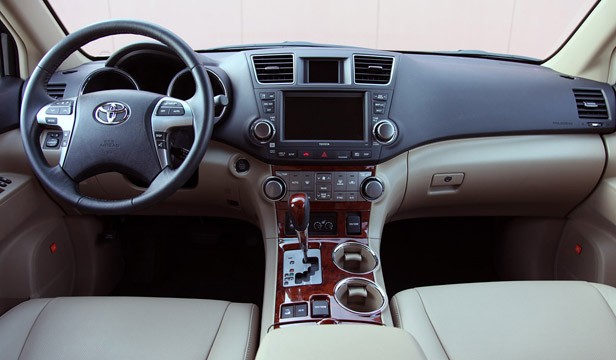
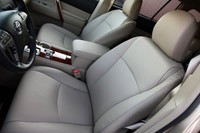
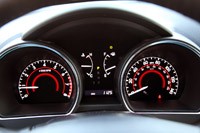
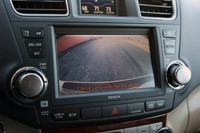

Sign in to post
Please sign in to leave a comment.
Continue